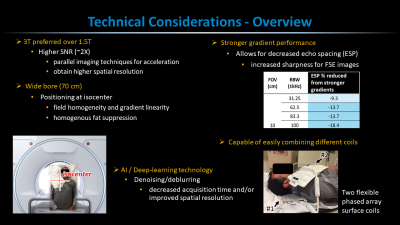Weekend Course
On the Run: Advanced MRI in Musculoskeletal Imaging
ISMRM & ISMRT Annual Meeting & Exhibition • 04-09 May 2024 • Singapore

| 13:15 |
Imaging of Synovitis: Techniques & Applications
John Waterton
Keywords: Musculoskeletal: Joints, Musculoskeletal: Tendons, Contrast mechanisms: Contrast agents Synovitis – inflammation of the synovial membrane – is important in several conditions including osteo- and rheumatoid arthritis. Gadolinium contrast-enhanced (CE) and dynamic contrast-enhanced (DCE) techniques are technically preferable, although non-contrast-enhanced techniques are emerging. Scoring systems provide ordered categorical biomarkers of extent of synovitis, and volume of enhancement also provides an extensive-variable biomarker. If intensity of inflammation is of interest, DCEMRI provides intensive-variable biomarkers based either on heuristics or on compartmental modelling. Choice of synovitis biomarker depends on context of use: prognostic or predictive biomarkers demand reproducibility while monitoring and response biomarkers demand repeatability and sensitivity to change. |
|
| 13:40 |
 |
Still Nerve Racking? Updates on Peripheral Nerve MRI
Philip Colucci
Keywords: Education Committee: Clinical MRI Magnetic resonance imaging of peripheral nerves (MR neurography) is an important adjunct to electrodiagnostic testing. It is helpful for lesion localization and aids in preoperative planning, resulting in smaller incisions and reduced surgical time. Advances in coil design as well as acquisition and post-processing techniques have led to improved image quality with decreased acquisition time. The resultant increase in spatial resolution coupled with isotropic 3D imaging allows for more accurate diagnostic evaluation. As such, MR neurography is increasingly utilized as an important tool in clinical decision-making and the formulation of treatment strategies for peripheral nerve abnormalities. |
| 14:05 |
Metal Madness: Imaging of Metal-Containing Body Parts
Kevin Koch
Keywords: Physics & Engineering: Implants, Image acquisition: Artefacts Metal implants are commonly encountered in MRI and negatively impact image quality, causing artifacts that obscure anatomy and pathology. Artifacts are managed clinically through conventional sequence parameter optimization and advanced MRI methods. However, residual artifacts persist, limiting diagnostic value near implants. New multi-spectral imaging approaches leverage material properties to mitigate artifacts. Understanding artifacts and current clinical approaches sets the stage for discussion on these emerging techniques. Optimizing workflows requires recognizing implants’ prevalence, artifacts’ effects on MRI interpretation, applying specialized protocols to maximize diagnostic yield for critical evaluations near implants. |
|
| 14:30 |
Stretch Your Legs: Quantitative & Functional Imaging of Muscle
Valentina Mazzoli
Keywords: Musculoskeletal: Skeletal, Contrast mechanisms: Microstructure . |
|
| 14:55 |
Break & Meet the Teachers |
|
| 15:20 |
More Is Better: Multi-Transmit & Multi-Excite Musculoskeletal
Imaging
Cem Deniz
Keywords: Physics & Engineering: High-Field MRI, Musculoskeletal: Joints The use of high field strengths opened new venues for MR imaging of MSK tissues. In this educational lecture, we will focus on parallel transmission techniques that will overcome challenges associated with high field strengths. The audience will learn the basic principles of parallel transmission and its use in MSK applications. |
|
| 15:45 |
Low-Field, High-Value: Updates on Musculoskeletal Applications
of Low-Field MRI
Krishna Nayak
|
|
| 16:15 |
Real-Time MRI of Joint Motion
Kevin Koch
|
|
| 16:35 |
Imaging of Bone: Osteoporosis, Obesity & Metabolic Bone Disease
Marco Barbieri
|
The International Society for Magnetic Resonance in Medicine is accredited by the Accreditation Council for Continuing Medical Education to provide continuing medical education for physicians.